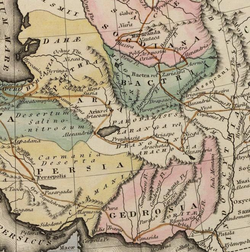Gedrosia
Γεδρωσία گدرۏچ | |
|---|---|
Region | |
 Map showing Gedrosia in the Indian campaign of Alexander the Great | |
| Country | Balochistan province of present-day Pakistan |
Gedrosia (/dʒɪˈdroʊʒə/; Greek: Γεδρωσία) is the Hellenized name of the part of coastal Baluchistan that roughly corresponds to today's Makran. In books about Alexander the Great and his successors, the area referred to as Gedrosia runs from the Indus River to the southern edge of the Strait of Hormuz. It is directly to the south of the countries of Bactria, Arachosia and Drangiana, to the east of the country of Carmania and due west of the Indus River. The native name of Gedrosia might have been Gwadar as there are two towns by that name and a bay (Gwadar Bay) in central Makran. [1][2]
History
Gedrosia was a region encompassing Balochistan province of present-day Pakistan. It was a part of Persian Empire before being conquered by Alexander the Great's army. [1] Following his army's refusal to continue marching east at the Hyphasis River in 326 BCE, Alexander the Great crossed the area after sailing south to the coast of the Arabian Sea on his way back to Babylon. Upon reaching the Ocean, Alexander the Great divided his forces in half, sending half back by sea to Susa under the command of Nearchus.[3] The other half of his army was to accompany him on a march through the Gedrosian desert, inland from the ocean.[4] Throughout the 60-day march through the desert, Alexander lost at least 12,000 soldiers, in addition to countless livestock, camp followers, and most of his baggage train.[5] Some historians say he lost three-quarters of his army to the harsh desert conditions along the way.[6] However, this figure was likely based on exaggerated numbers in his forces prior to the march, which were likely in the range of no fewer than 30,000 soldiers.[7]
There are two competing theories for the purpose of Alexander's decision to march through the desert rather than along the more hospitable coast. The first argues that this was an attempt to punish his men for their refusal to continue eastward at the Hyphasis River.[8] The other argues that Alexander was attempting to imitate and succeed in the actions of Cyrus the Great, who had failed to cross the desert.[7]
After the death of Alexander, this region became part of the holdings of Seleucus, who also held Ariya (modern-day Kabul), Gedrosia (Baluchistan), Arakeshiya (Kandhar), and Peripemisdai (Herat). [2]
See also
References
- ^ a b The Journal of the Bihar Research Society. Bihar Research Society. 1949. p. 74.
Gedrosia and Saurashtra had formed important parts of the Mauryan empire before the Indo-Greek adventurers attacked in on the west.
- ^ a b Ray, Himanshu Prabha (2003). The Archaeology of Seafaring in Ancient South Asia. Cambridge University Press. ISBN 978-0-521-01109-9.
In spite of the vagueness of the historical texts, the consensus among scholars is that the treaty concluded between Candragupta Maurya and Seleucus acknowledged Indian control of territories to the west of the Indus. These included Gedrosia, Paropamisadae (the region of Kabul and Begram) and Arachosia (the Kandahar region).
- ^ Bosworth (1988), p. 139
- ^ Bosworth (1988), p. 142
- ^ Bosworth (1988), p. 145
- ^ Plutarch, The Life of Alexander, 66.
- ^ a b Bosworth (1988), p. 146
- ^ Heckel (2002), p. 68
Bibliography
- Bosworth, A. B. (1988). Conquest and Empire: The Reign of Alexander the Great. Canto. Cambridge University Press. ISBN 9780521406796.
{{cite book}}: Invalid|ref=harv(help) - Heckel, Waldemar (2002). The Wars of Alexander the Great. Essential Histories. Osprey. ISBN 9781841764733.
{{cite book}}: Invalid|ref=harv(help) - Saul, David (2009). War: From Ancient Egypt to Iraq. Dorling Kindersley. ISBN 9781405341332.
{{cite book}}: Invalid|ref=harv(help)